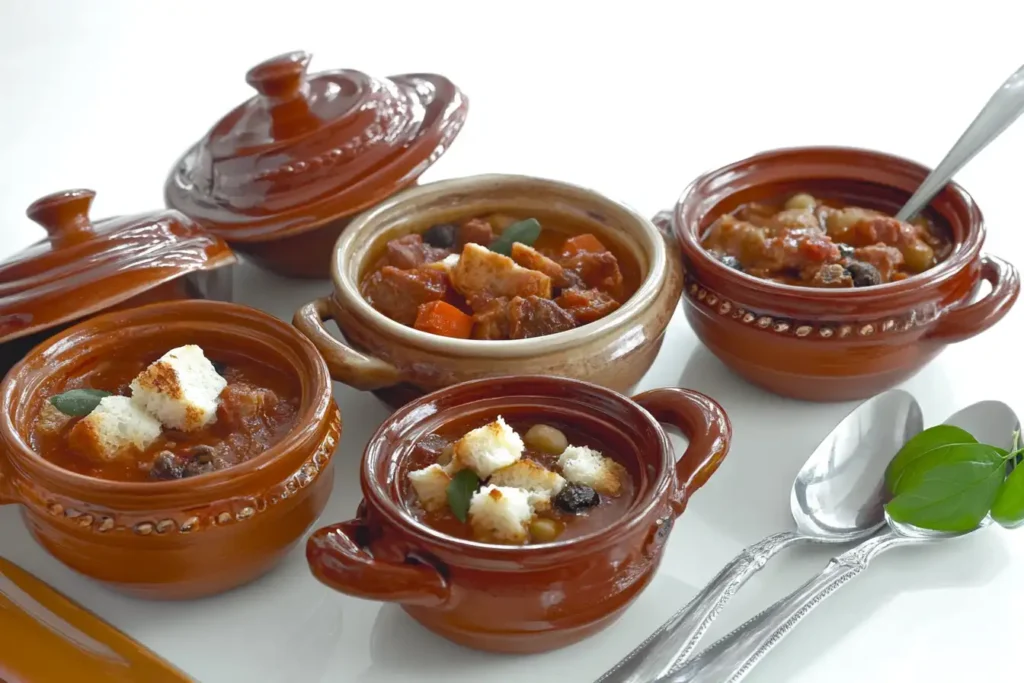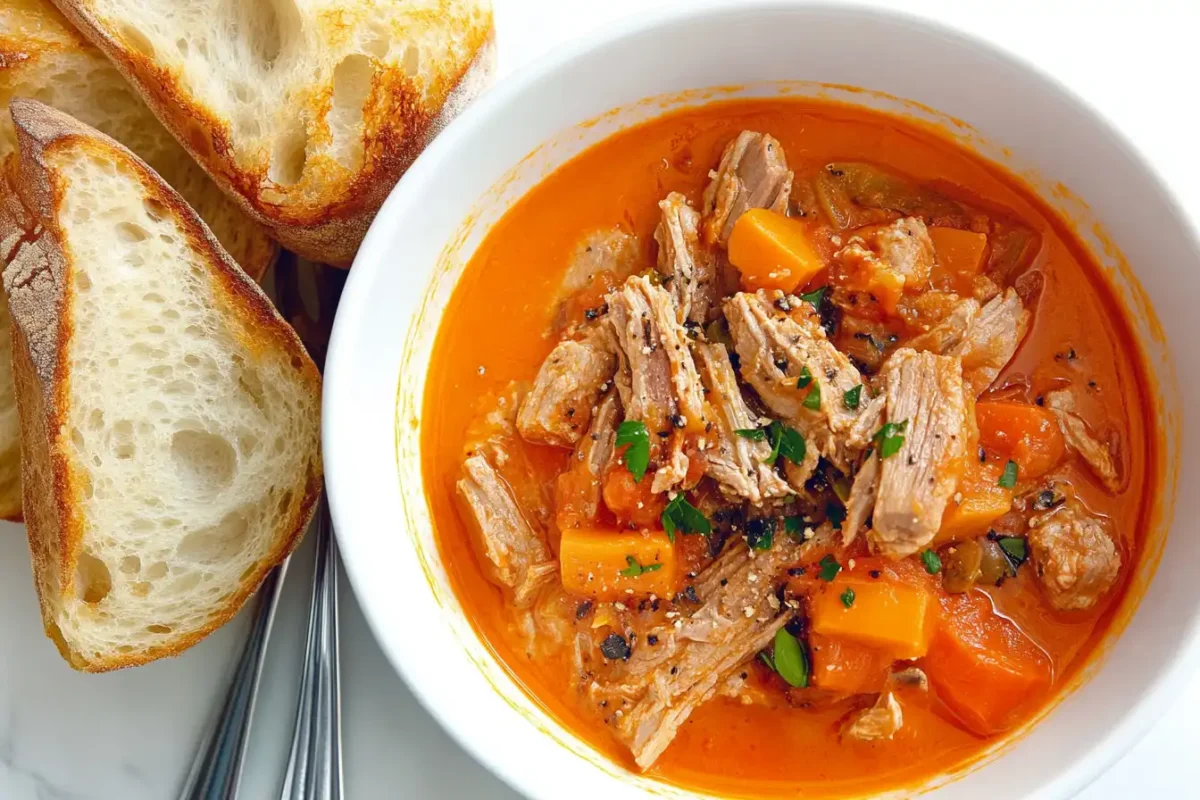Discover the Spanish word for stew, explore its history, and master authentic recipes in this comprehensive guide.
Welcome to this extensive exploration of Spanish stew, an essential pillar of Spanish home cooking. Below, you will find everything from its medieval roots to modern variations across different Spanish regions. You will also learn tips to perfect this iconic dish in your kitchen. Read on to discover how what is the Spanish word for stew? shapes cultural identity and culinary enjoyment.
A Brief History of Spanish Stew
Stew holds a special place in Spain’s gastronomic history. Initially, it emerged as a comforting solution to feed large families on a budget. Medieval households commonly relied on slow-simmered dishes. This allowed cheaper cuts of meat to become tender while blending flavors from fresh vegetables, spices, and herbs.
Consequently, the tradition spread across the Iberian Peninsula. Romans introduced wheat and olives, while the Moors popularized saffron and other exotic seasonings. Eventually, New World ingredients like tomatoes and potatoes expanded the range of Spanish stew recipes. Altogether, this fusion defined the evolving Spanish palate.
Chiefly served at family gatherings, Spanish stew became an expression of regional identity. Indeed, every province in Spain developed a signature recipe. Over time, “cocido” (or “boiled dish”) took hold in Madrid, and “fabada” rose to fame in Asturias. While these names vary, they all illustrate one truth: Spanish stew continues to unify households.
Common Spanish Terms for Stew
Spain boasts several words for stew. Most people refer to this hearty dish as “cocido,” “estofado,” “guiso,” or “puchero.” Each word reflects a subtle difference, though they often overlap. “Cocido,” for instance, implies slow-cooking ingredients in broth until flavors merge. “Estofado” suggests an enclosed cooking method, frequently involving a lid to trap steam.
Equally important, “guiso” typically refers to a stew with a thick sauce. This dish often incorporates a “sofrito,” a base of sautéed onions, garlic, peppers, and tomatoes. Meanwhile, “puchero” is a traditional pot-based meal, especially in southern regions. Comparatively, some cooks argue that “puchero” resembles “cocido” but with local variations in proteins and vegetables. However, all these terms represent nourishing meals that highlight Spain’s love for bold flavors.
What is the Spanish word for stew? A Linguistic Overview
What is the Spanish word for stew? This simple question leads to a complex cultural tapestry. The term “cocido” stands out as a cornerstone in central Spain, particularly in Madrid. Meanwhile, “guiso” appears throughout many Latin American regions influenced by Spanish heritage. “Estofado” echoes a French-derived process of slow-simmering meat with wine.
Basically, each region chooses the term that best captures its customary approach. Consequently, you might hear “cocido” in one household and “estofado” in another. Nonetheless, these terms share an undeniable heritage. Stew in Spanish culture is more than just food. It is a reflection of comfort, economy, and hospitality.
Initially, you might find it confusing to hear so many names for a single dish. Nonetheless, they maintain slight differences in ingredients, cooking technique, and serving style. Indeed, this variety is what keeps Spanish gastronomy vibrant.
What is the Spanish word for stew? Exploring Traditional Dishes
What is the Spanish word for stew? becomes even clearer once we examine specific recipes. Four notable stews include Cocido Madrileño, Fabada Asturiana, Olla Gitana, and Pote Gallego. Each reveals unique cooking methods and ingredients.
- Cocido Madrileño
This emblematic dish from Madrid begins with chickpeas, potatoes, and carrots. Often, cooks add chorizo, morcilla (blood sausage), and a pork bone. The slow-cooking process imparts deep layers of flavor. Eventually, the broth is separated and served as a first course, followed by the hearty meats and vegetables. - Fabada Asturiana
Originating from Asturias, Fabada features large white beans known as fabes. Typically, it includes a combination of smoked chorizo, morcilla, and pork shoulder. The stew cooks for hours, thus developing a thick, creamy texture. Especially in winter, locals enjoy Fabada for its warming and satisfying qualities. - Olla Gitana
This colorful stew originates from southern Spain, particularly Murcia and Andalusia. Another name is the “Gypsy Pot,” referencing its eclectic mix of vegetables. Pears, pumpkin, chickpeas, and green beans often appear. Comparatively, some variations include saffron or mint, producing a sweet and savory balance. - Pote Gallego
Galicia is known for its green landscapes and rainy weather, so a hearty stew like Pote Gallego fits the climate. Turnip greens (“grelos”), white beans, and salted pork are classic staples. Because of the region’s coastline, fish or shellfish can also appear as a flavorful addition.
What is the Spanish word for stew? Tips for Mastering Flavor
Despite regional differences, cooks follow similar principles to maximize taste. What is the Spanish word for stew? might lead you to “guiso” or “cocido,” but the path to deliciousness remains consistent. Firstly, choose quality ingredients. Fresh vegetables, seasonal produce, and properly cured sausages are key. Furthermore, layering flavors with a proper “sofrito” yields a robust taste.
Meanwhile, the cooking process matters. Many Spanish stews rely on slow, gentle simmering. Basically, this method breaks down tough meats and unifies flavors. If time is short, you can use a pressure cooker for efficiency. Nonetheless, the result should maintain a luscious, thick broth. Traditionally, a well-made stew does not rush. Each spoonful should taste like comfort and tradition.
Finally, seasoning plays a crucial role. Generously use garlic, onions, paprika, and bay leaves. Chiefly, Spanish paprika (“pimentón”) contributes a smoky dimension. Add salt sparingly at first, then adjust to taste after the stew has cooked. This approach prevents over-salting and ensures balanced seasoning.
What is the Spanish word for stew? Key Terminology
We have explored the diversity of Spanish stew terms. Still, there are other words crucial to understanding this cuisine. What is the Spanish word for stew? might lead you to “estofado,” but consider two essential components: caldo (broth) and sofrito (sauteed base). Both are indispensable building blocks.
- Caldo (broth): This is the liquid that forms the foundation of many stews. Typically made from bones, vegetables, and aromatics, caldo imparts depth and warmth.
- Sofrito (base): Sofrito combines onions, garlic, tomatoes, and peppers, cooked in olive oil. Consequently, this forms a flavorful foundation that ties all other ingredients together.
Altogether, understanding these terms helps you navigate Spanish recipes. Stew often starts with sofrito, then you add proteins, vegetables, and caldo. Finally, everything simmers until it harmonizes.
What is the Spanish word for stew? Essential Ingredients

Essential ingredients vary by region, but certain staples appear in almost every Spanish stew. For proteins, you often see chicken, beef, pork, or fish. Occasionally, cooks add cured meats like ham hock, bacon, chorizo, or morcilla. These ingredients intensify the stew’s flavor and texture.
Vegetables commonly include onions, carrots, bell peppers, and tomatoes. Potatoes and chickpeas add body and starch. Meanwhile, spices such as paprika, saffron, bay leaves, and thyme elevate the entire dish. What is the Spanish word for stew? might be “guiso,” yet the real magic occurs when fresh produce meets classic seasonings.
Furthermore, olive oil is a cornerstone of Spanish cooking. Basically, it is used for sautéing and flavoring. In many cases, olive oil also enriches the final taste. Comparatively, other cuisines might rely on butter or vegetable oil. Nonetheless, Spain’s abundant olive groves ensure that olive oil remains fundamental.
What is the Spanish word for stew? Serving Suggestions
Serving suggestions can transform a simple stew into a memorable meal. What is the Spanish word for stew? might be “cocido,” but how you present it also matters. Typically, Spaniards serve stew with crusty bread to mop up the broth. Sometimes, they add rice or noodles to the pot, creating a heartier dish.
Because Spanish stews are filling, they often serve as a single main course. Still, side dishes like roasted peppers or a simple salad can provide contrast. A light dessert such as flan or fresh fruit also complements the robust stew flavor. For beverage pairing, many opt for red wine like Tempranillo or Garnacha. White wine or cider can also work well, especially with lighter fish-based stews.
Health Benefits of Spanish Stews
Stews are generally nutritious if prepared with healthy ingredients. Vegetables like carrots, onions, and peppers supply vitamins. Legumes, including chickpeas and beans, offer protein and fiber. Moreover, the slow-cooking process can help preserve nutrient density. Consequently, Spanish stews make for a balanced meal, especially when you include plenty of vegetables and lean cuts of meat.
Nonetheless, it is essential to moderate the use of high-fat sausages and salty cured meats. You can reduce sodium by rinsing canned beans and using low-sodium broth. Likewise, reduce the amount of fatty cuts of pork to keep the stew heart-healthy. Generally, Spanish stews can adapt to different dietary needs. You can replace meats with extra vegetables or fish, while still maintaining robust flavors.
Because Spanish cuisine celebrates fresh produce, you will find local markets stocked with seasonal offerings. This approach supports sustainable agriculture and ensures maximum flavor. Thus, a typical Spanish stew embodies the Mediterranean diet principle of balance. As a result, you can enjoy a delicious, comforting dish that aligns with healthy eating.
Regional Twists on Spanish Stews

While the core idea remains consistent, every corner of Spain features a unique stew. In Cataluña, “Escudella i Carn d’Olla” includes a distinctive mix of meatballs, sausages, and pasta. Conversely, Andalusia’s “Puchero Andaluz” might add mint leaves or chickpeas. The Basque Country is known for sophisticated stews with local fish and shellfish, reflecting the coastal environment.
Meanwhile, central Spain often uses lamb or pork, whereas coastal areas rely more on seafood. Comparatively, the sauces differ as well. Some stews have a thinner broth, while others are thickened by mashed vegetables or stale bread. Undoubtedly, these variations stem from resourcefulness and local tastes. Regardless, the unifying theme is comfort, hospitality, and the joy of sharing a hearty meal.
Indeed, exploring these diverse stews can be a journey across Spain’s geography. Every region offers its spin on what is the Spanish word for stew? While the answer shifts, the warm spirit behind it remains the same.
Frequently Asked Questions (FAQs)
1. What is Spanish stew called?
Spanish stew can be called many names, such as “cocido,” “estofado,” or “guiso.” The term depends on regional preference and cooking style.
2. What is the word for Mexican stew?
In Mexican cuisine, the word for stew is often “guiso” or “estofado.” Another common term is “caldillo.” Mexican stews also incorporate chilies and local spices.
3. What is beef stew in Spanish?
Beef stew may be referred to as “estofado de carne” or “guiso de ternera.” The exact terminology varies by region. However, these names generally indicate a slow-cooked beef dish.
4. What is the translation of stew?
“Stew” in English translates broadly as “estofado,” “cocido,” or “guiso” in Spanish. Some areas simply say “puchero.” Context determines which word fits best.
Conclusion
Throughout Spain, stew exemplifies tradition and comfort. Families gather around a simmering pot of vegetables, meat, and fragrant spices. While you might ask, What is the Spanish word for stew? and hear “cocido,” “estofado,” or “guiso,” they all embody the heart of Spanish home cooking. Each region contributes its own twist, showcasing local ingredients and age-old methods.
Ultimately, stew transcends language. Its essence unites people across the country, highlighting warmth and shared heritage. Whether you enjoy Cocido Madrileño or Fabada Asturiana, you are partaking in a tradition that stretches back centuries. Indeed, Spain’s iconic stews continue to captivate food lovers worldwide.
Embrace these recipes in your kitchen. Rely on fresh, quality ingredients and give the flavors time to meld. Adjust the spices to your liking. Then, serve it all with a crusty piece of bread or a bowl of rice. In doing so, you partake in the quintessential spirit of Spanish cuisine. So, whenever you wonder, What is the Spanish word for stew? you now know the delicious and varied answer.
FOR MORE DELICIOUS RECIPES:
Does Salmon Taste Good Deep Fried? A Crispy Delight

